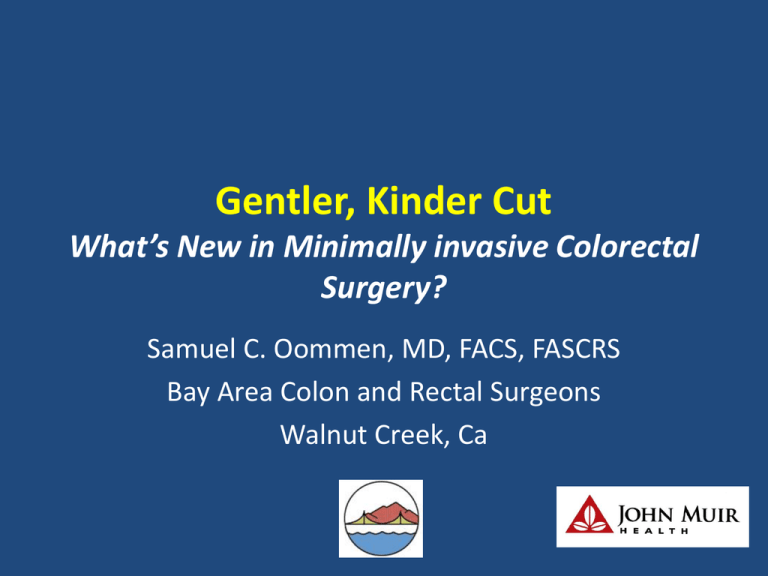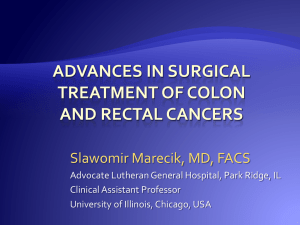
Gentler, Kinder Cut
What’s New in Minimally invasive Colorectal
Surgery?
Samuel C. Oommen, MD, FACS, FASCRS
Bay Area Colon and Rectal Surgeons
Walnut Creek, Ca
Topics To be Covered
• Trans anal Endoscopic Microsurgery
(TEM)
• Laparoscopic Colectomy
• Total Mesorectal Excision & Autonomic
Nerve Preservation (TME & ANP)
• Hand Assisted Laparoscopic Surgery
(HALS)
• Robotic Colorectal Surgery
Trans anal Endoscopic Microsurgery
(TEM)
Transanal Endoscopic Microsurgery
Introduced by Gerhard Buess in 1983 for
excision of proximal rectal lesions not
amenable to a standard Transanal
excision(TAE)
Operating Proctoscope with ports for CO2
insufflation and instrumentation
Six fold stereoscopic view
Facilitates negative surgical margins when
direct visualization of the radial extent of
the tumor is visible
TRANSANAL ENDSCOPIC
MICROSURGERY
(TEM)
Indications For TEM
Adenocarcinoma
T1 lesion (Confined to Submucosa)
Well or Moderately differentiated
Without Lympho vascular invasion
T2 lesion (Muscle Invasion)following preop
chemo radiation under ACOSOG Z 6041 protocol
Carcinoid(< 2 cm)
Adenoma unable or incompletely excised by
endoscopy
Residual neoplasm or uncertain margin after
endoscopic resection
Excision of benign rectal stenoses
Palliation of advanced cancer in high risk patients
TEM
Technique
•Proctoscopic exam
•Isolate tumor in lower
half of field of view
•Secure scope in place
with Martin Arm
Courtesy Peter Cataldo, MD
TEM
Technique
Direct view through
stereoscope or on
monitor
Courtesy Peter Cataldo, MD
Technique
Inject lesion with
lidocaine w/
epinephrine
Courtesy Peter Cataldo, MD
ENDOSCOPIC VIEW
Multifocal Dysplastic Adenoma (TEM Specimen)
T1 Polypoid Cancer
TEM specimen
T2 Adenocarcinoma of Mid Rectum
TEM VIDEO
TEM for Rectal Cancer?
Oncologic Results
TEM vs. Radical Resection
Winde et. al. Munster, Germany
•
•
•
•
•
•
•
Prospective, randomized trial
uT1N0
52 patients
TEM vs. Ant. Resection
Morbidity / mortality
Recurrence
Survival
TEM vs. Radical Resection
Winde et. al. Munster, Germany
Complications
TEM 20.8% vs. LAR 34.5%
Local recurrence
TEM 2/24(8%) vs. LAR (?)
Survival
TEM 23/24 (96%) vs. LAR 25/26 (96%)
TEM
Oncologic Results
•
•
•
•
•
•
•
LeZoche et al
Rome, Italy
40 patients, 3 yr f/u
prospective, randomized trial
T2N0
Preop chemoradiotherapy
TEM vs LAR
TEM vs Lap LAR
T2N0
OR time
LOS
Compl
Local rec.
3 yr. Surv.
TEM
LAR
95 min
4.5 days
15%
5%
90%
165 min
7.5 days
15%
5%
83%
Laparoscopic Colorectal Surgery
Historical Perspectives
1990: Laparoscopic Right ColectomyJacobs, Miami, Florida
*Jacobs M. et al Minimally Invasive Colon Resection, Surg Laparosc Endosc 1991; 1: 144-50
2004: COST Study
Recurrence
&
Survival
Benefits of Laparoscopic Surgery
• Smaller incisions
• Reduced postoperative pain
• Earlier return of bowel function
• Reduced hospital stay
• Earlier return to work and activities of
daily living
• Reduced operative trauma and stress
• Reduced adhesions
Endoscopic Tattoo
Right Colectomy
Right Colon Anatomy
Adequate Lymph Node Harvest
Total Mesorectal Excision
(TME)
What is Total Mesorectal Excision?
“TME is defined as the resection of the rectum with
its surrounding fatty and lymphatic tissue contained
within the visceral sheet (Fascia Propria) of the
endopelvic fascia. The dissection in this almost
avascular cleavage allows the complete removal of
the mesorectal tissue, as well as good protection of
the hypogastric nerves and the inferior hypogastric
plexus, resulting in less disturbance to bladder and
sexual functions.”
Faerden AE et al, Dis Colon Rectum , 2005; 48: 2224-2231
Adapted from Heald, RJ et al, Br. J. Surg Vol 69(1982)613-616
Total Mesorectal Excision (TME)
Shiny Fascia Propria covering
the Mesorectum
Total Mesorectal Excision (TME)
TME Grading
• COMPLETE:
– Intact bulky mesorectum
with a smooth surface
– Only minor irregularities
of mesorectal surface
– No coning towards the
distal margin of the
specimen
– After transverse
sectioning, the
circumferential margin
appears smooth
TME Grading
• NEARLY COMPLETE:
– Moderate bulk to the
mesorectum
– Irregularity of the
mesorectal surface with
defects greater than 5
mm, but none extending
to the muscularis propria
– No areas of visibility of
muscularis propria
TME Grading
• INCOMPLETE –
– Little bulk to the
mesorectum
– Defects in the
mesorectum down to
muscularis propria
– After transverse
sectiong, the
circumferential margin
appears very irregular
Mesorectal grade vs. local and overall recurrence
Grade of
Mesorectum
Total
Patients
(n)
Local
Recurrence
n (%)
Overall
Recurrence
n (%)
1
17
7 (41)
10 (59)
2
52
3 (5.7)
9 (17)
3
61
1 (1.6)
1 (1.6)
0.0001
0.0001
P value
From Maslekar et al. 2006 “Mesorectal grades predict recurrences after curative
resection for rectal cancer.” Dis Colon Rectum 50:168-175.
Hand Assisted laparoscopic Surgery
• Still the best Surgical
instrument
• Tactile feedback for
retraction and dissection
• May reduce operative
times and need for
conversion
• Bridge between open and
laparoscopic surgery
• Two Commandments
Adapted from Michael McCue, MD
Two Commandments of laparoscopic
surgery.
• “Thou Shall not change your operation to
fit the equipment”
• “Thou shall K. I. S. S. (keep it simple
surgeons)”
• HALS is ideal in meeting above criteria.
Adapted from Michael McCue, MD
Benefits of HALS
Maintains Tactile Feedback
Improves Eye Hand coordination and Depth
perception
Better exposure due to improved traction
Facilitates rapid hemorrhage control
No Laparoscopic instrument is as
versatile, educated and safe as the
experienced Surgeon’s Hand
Lap Disc Ethicon Endosurgery
Hand Assisted Right Colectomy for Hepatic Flexure
Cancer
HALS
Robotic Colorectal Surgery
Disadvantages of Laparoscopic surgery
•Unstable video camera
imaging
•Dependency on assistant’s
skills
Disadvantages of Laparoscopic surgery
• Limited motion of instruments
The Surgical instruments are Rod-like having no
wrist movement at the tip which required from
the surgeon to move his arms in large scale
movements outside the patients body for the
instrument tip (internally) to get to the desired
location.
The movement of the instruments/scope were
awkward (counter-intuitive) meaning that if the
surgeon wants to move the instrument/scope to
the left, he has to move to the right from outside.
Related loss of dexterity
Disadvantages of Laparoscopic surgery
(Contd)
• The scope displays only a 2D image on
the display which has no depth
perception. The surgeon needed to
over/under shoot the target anatomy to
be able to allocate it properly.
• The Surgeon gets tired
• Awkward position such as twisting his neck
to be able to follow up the surgical site
displayed on the monitor.
• Longer hours standing
Advantages of Robotic Surgery
• Tridimensional(3D) imaging under
the surgeon’s direct control
• Provides instruments with seven
degrees of freedom
• Enhances dexterity, precision, and
control during surgical procedures.
Advantages of Robotic Surgery
(Contd)
.
• Scales down hand movements,
and eliminates hand tremors
• Facilitates handsewn sutures.
• Cuts down the surgeon’s
fatigue
OR Setup and Patient Preparation
Patient Positioning
Docking The Patient Cart
Surgical Steps - Surgical Overview
Robotic Colorectal Surgery
Disadvantages of Robotic Surgery
• Cost. With a price tag of 1.6 million
dollars, and nearly 100k in maintenance
costs annually.
• the size of these systems.
• lack of compatible instruments like
energy sources and staplers.
• Lack of tactile feedback
Conclusion
• Generally, the maximum benefit seems to be
achieved whenever a complex and precise dissection
in a confined space is required.
• Still in infancy, and many advances are expected in
the near future (smaller and operative-room
integrated systems, tactile feedback technology,
specifically designed instruments, reduced costs)
• Robotic laparoscopic colon surgery is feasible and
safe.
• Operating time is longer than in standard
laparoscopic surgery.
• Results from long term studies studies regarding
cancer survival and recurrence are awaited










